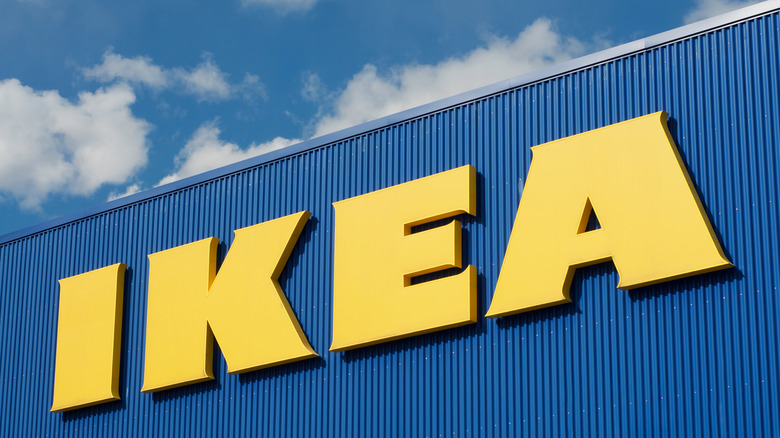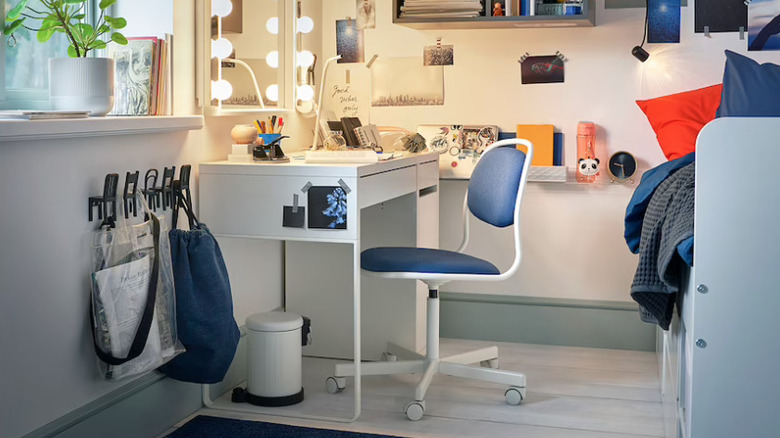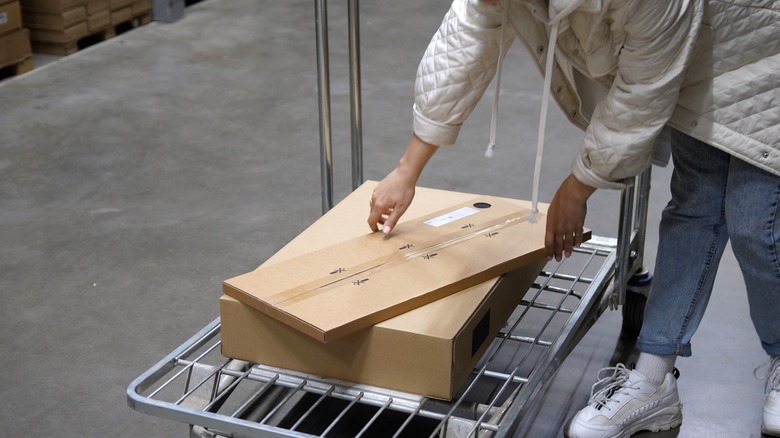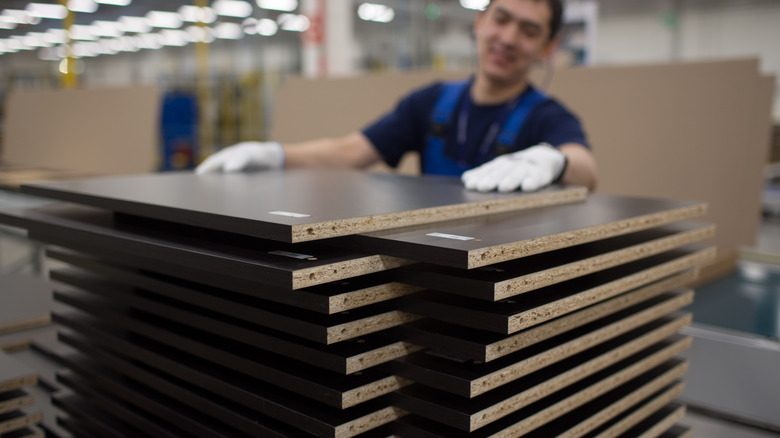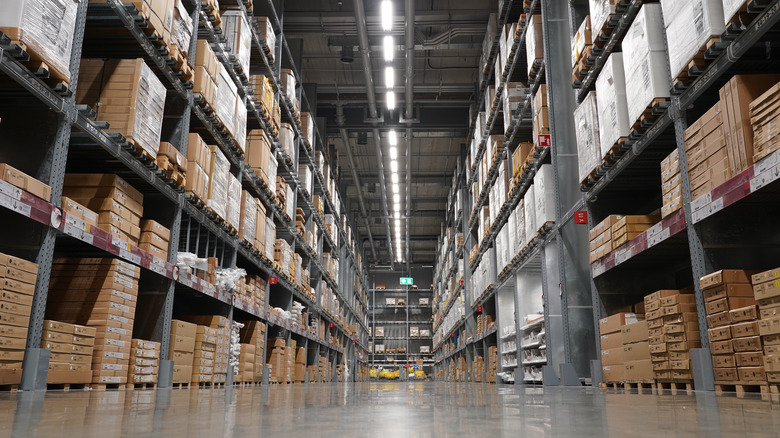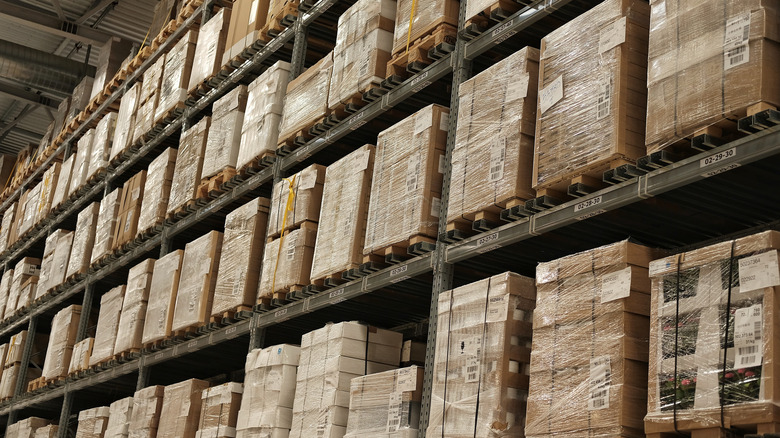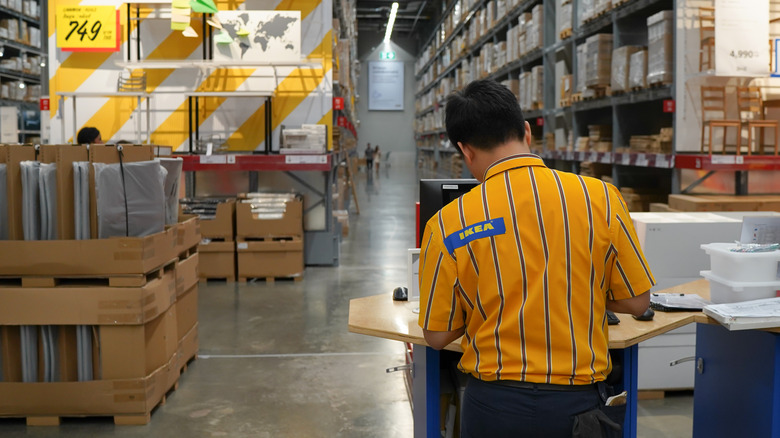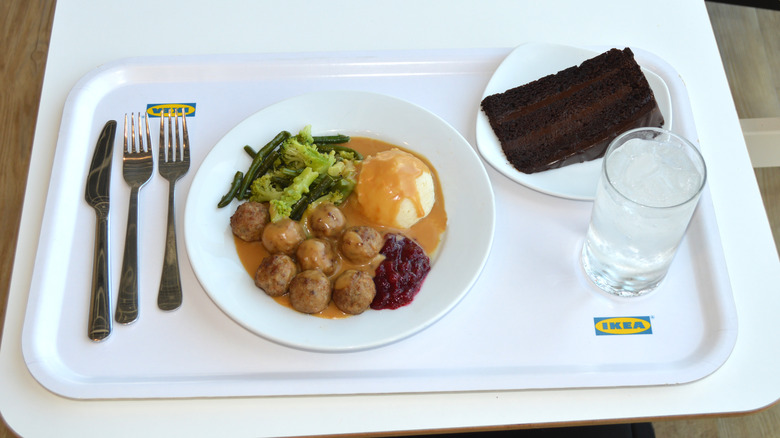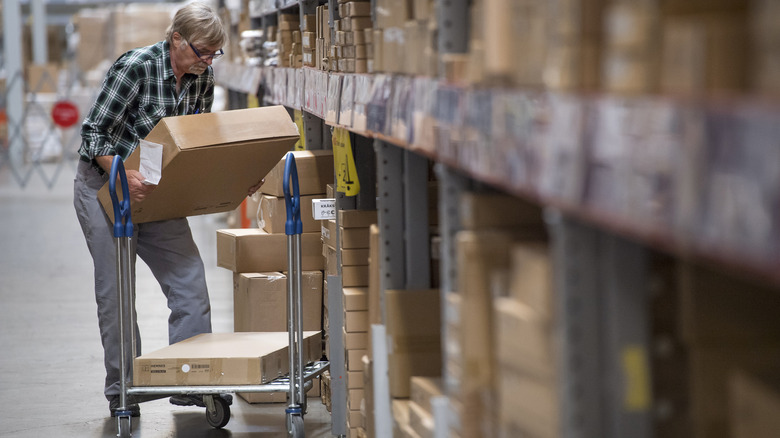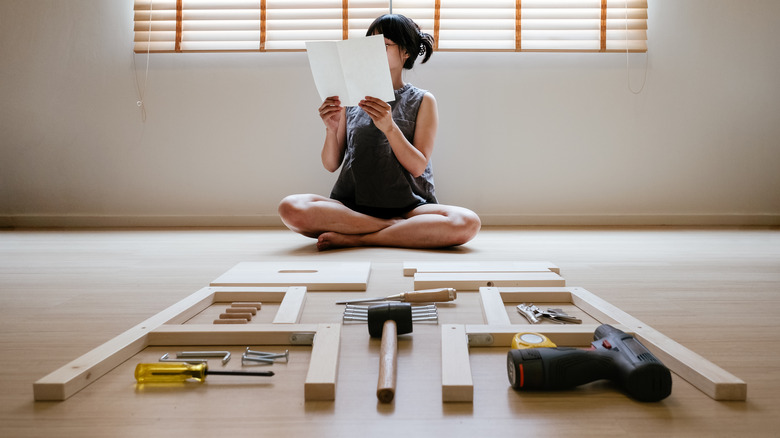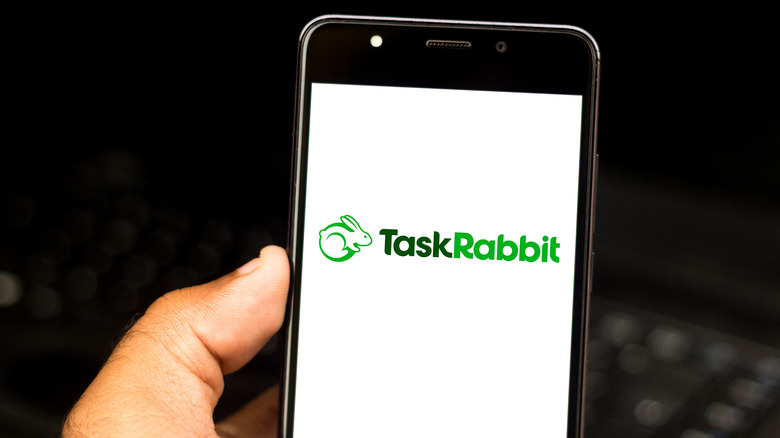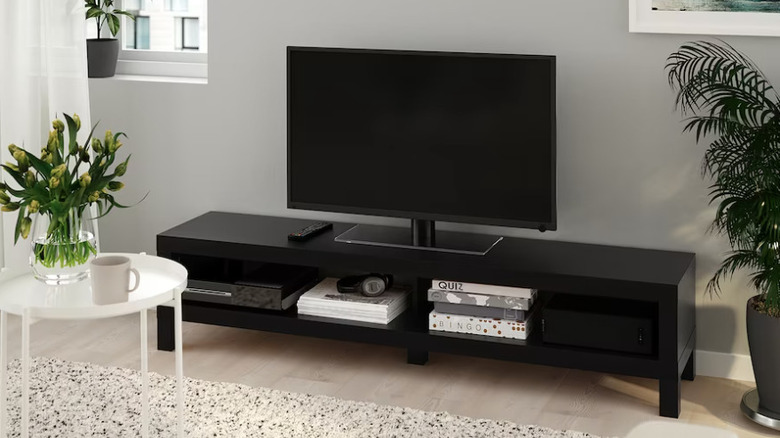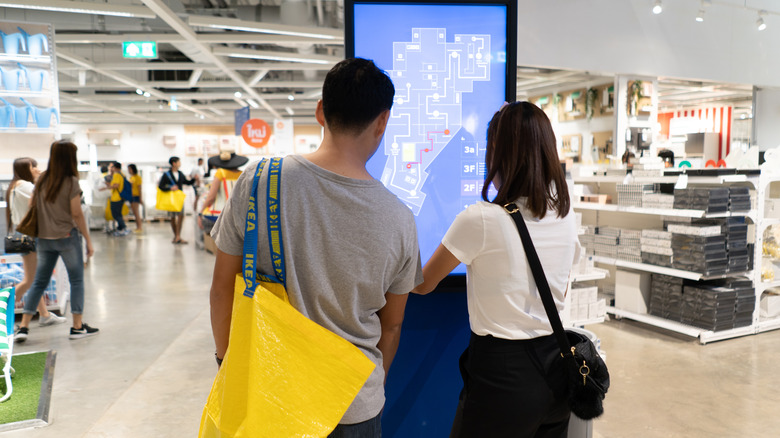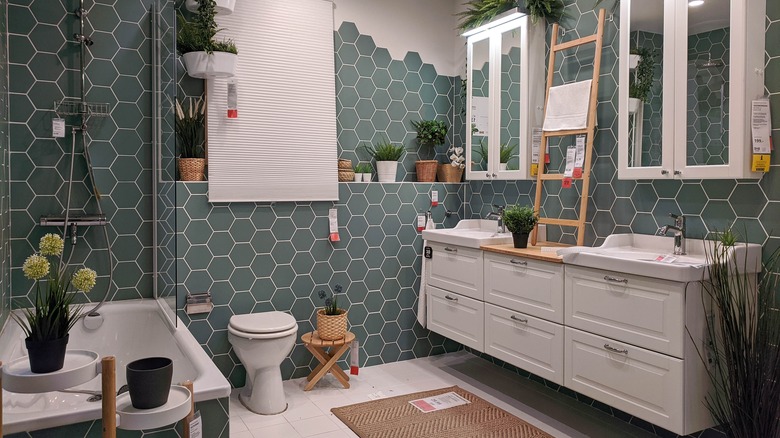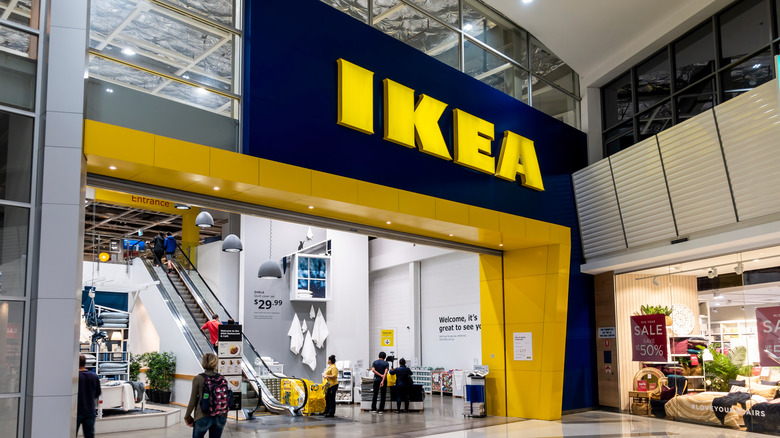Ikea's Secrets To Keeping Their Prices Low
IKEA is unlike any other furniture store out there. Founded in 1943, they nailed down their offerings to a science over the past 80 years. From the large variety of furniture pieces and home items to their DIY business model, they put themselves in a unique category to simplify the entire experience of visiting one of their stores. Beyond their Swedish meatballs (which now come in both chicken and plant-based varieties, may we add), IKEA is known for its affordable prices.
Though their prices vary, as EnvZone reports, Ikea sells their furniture items for about half of what you would need to pay elsewhere. As Antonella Pucarelli, the commercial officer of IKEA retail U.S., said to EnvZone, the retailer "deliver[s] form, function and quality products at a low price. Even though our products are affordable, we don't compromise on quality." But how exactly does IKEA manage to do this? We're revealing all the secrets to their low prices below. Here are some things you probably don't know about IKEA.
They design around the price
IKEA is different from other furniture manufacturers in its design and pricing process. Rather than designing the item and then pricing it after it's complete, IKEA first decides on the approximate price they'd like the item to be and then complete the design accordingly. Per Krokstäde, former business manager of IKEA Sweden, told Insider, "We don't say that a product has to cost exactly $8.50. But we do say we want to design a folding chair in our so-called 'lower price category.' Next, we draft a target price, like $7.99. And then we work toward that goal."
Some things they consider when trying to adhere to a target price include the choice of materials and how much material will need to be used, as well as how much it'll cost to transport the product and how much they'll be able to fit on a single shipping pallet. Yet, IKEA never sacrifices quality for the sole purpose of a low price. The furniture conglomerate constantly balances form, function, quality, sustainability, and low prices to design the perfect product.
Flat packaging
IKEA may not necessarily be the first to use flat packaging, but they've claimed it as one of their signature practices. By selling the furniture in pieces, rather than as a whole, they can pack everything in slender boxes (known as flatpacks), which saves them big on storage and transportation costs — both for IKEA and the consumer taking them home from the store. The flat packaging design also helps prevent damage, so IKEA saves money by reducing the number of replacements they have to send out. All this allows them to keep their prices low.
As IKEA explains, it all started when IKEA veteran designer Gillis Lundgren (he's responsible for the BILLY bookcase and the IKEA logo) had to transport a table to a photo studio but couldn't fit it in his car. He took the table apart, and not too long after, IKEA flatpacks were born. They completely revolutionized their business model.
Their construction technique
The interior of many IKEA pieces is honeycomb paper filling. Before you freak out about your MALM desk made of paper — like James L. Sutter on Twitter did — let us explain why IKEA's construction technique and materials are actually quite genius (and not to mention cost-effective).
The honeycomb paper filling comes from 100% recycled paper, which is great for sustainability. Additionally, by using paper filling, IKEA doesn't need to use as much wood, which keeps costs down. While there are some things you should never buy from IKEA, the material should not be a reason to stay away. As an IKEA spokesperson told The Mirror in response to Mr. Sutter's discovery, "At IKEA all of our products are designed with form, function, sustainability, affordability, and quality in mind. In order to minimize waste, we strive to use materials in the most efficient way. By using a strong honeycomb pattern paper filling inside some products it allows us to produce more pieces using less raw materials and at the same time reduce the price for people without compromising on quality."
Bulk production
If you've ever been to the IKEA warehouse that awaits you at the end of your walking tour through the showroom, it probably comes as no surprise that the furniture retailer produces its products in bulk. By using large-scale production, they keep labor costs low. Further, as The Sharpener explains, IKEA's warehouses use automatic storage and retrieval systems. For perspective, a retailer with far fewer products in the rotation will most likely rely on manual labor in the warehouses. Manual labor means more workers need to be paid, which jacks up the price of the entire process.
Beyond their popularity and the high demand for their products, IKEA can produce in bulk because many parts feature in several designs. For example, the legs used for a dining room table may be the same ones used on an office desk, allowing IKEA to produce much higher quantities of most parts.
High quantity purchases
Since IKEA produces their items in bulk, they can buy materials in bulk, allowing them to secure some pretty great prices. Most suppliers (including the ones IKEA sources from) give discounts when customers order a larger quantity. Think about stores like Costco. You get a better deal per roll when you buy a 30-pack of toilet paper than when you buy a 6-pack at your local grocery store. This deal is why IKEA can decrease the prices of their most popular items — the materials come at a lower price as the demand increases. According to Medium, a high-volume, low-margin strategy is a successful approach.
This low-profit margin approach allows a company to accomplish a high sale rate and higher revenue (via Syncoria). It may sound counter-intuitive at first, but it's the real deal, and IKEA has mastered it. Plus, lowered costs of favorite items keep the customer happy.
Their self-help business model
While you will find some employees ready to assist you when shopping at IKEA, as a whole — especially compared to the size of the store and amount of customers inside — they have way fewer associates on staff than other retailers. That's because IKEA relies on a self-help business model, in which it primarily lets customers manage and decide on their purchases. You may think this would cause many problems and lead to unhappy shoppers, but IKEA has it down to a science. They can provide almost any information that a customer may need and streamline the process as a whole.
As Bizwoman reports, in 2018, IKEA announced that they would be implementing 7,500 job cuts over the following two years. Part of this, of course, is due to the growing popularity of e-commerce. With a self-help system, IKEA can afford the luxury of employing fewer people.
Affordable food
In addition to affordable furniture, IKEA is known for its food court — and, of course, the famous Swedish meatballs. In fact, according to Fast Company, 30 percent of IKEA food court diners come to the store for exactly that: to eat. As with their furniture and home accessories, their food options are inexpensive. When was the last time you paid under $3 for two hot dogs and a drink? We're pretty sure we've spent more than that for a pack of gum at the airport.
If you haven't guessed yet, there is a reason for their cheap eats. It gets people to the store, keeps them there longer, and gives them a full belly for a fair price. A former chef at IKEA, Chris Spear, dished to Quora, "Their policy is to be the absolute lowest price on that item within a 30 mile radius, even if it means selling at a loss. They're reinforcing the low-price profile of the store. So, they take a hit on the food, but just sold you $1,000 in furniture."
Their take it home today approach
The most common way customers get their IKEA pieces home is to take them back themselves on the same day they go shopping. While loading up your car with boxes may not be your favorite thing (hey, at least they're flatpacks, right?), it plays a substantial role in keeping those prices low. By putting the responsibility on the customer, IKEA saves money on employing delivery people and covering delivery fees.
Of course, a delivery option does exist, but it's not necessarily cheap. Delivery costs for anything that isn't considered a small item (think hangers and picture frames) start at $49, and it's an extra $20 if you want it brought into a specific room in your house. Shopping Behavior Xplained says it's best to order several things to make the delivery worth the cost. IKEA is all about doing things in bulk, so they price their delivery by order rather than an individual item.
DIY assembly
The IKEA DIY mentality doesn't stop with simply bringing home your items yourself. It continues with the essential step of assembling your own furniture. IKEA doesn't have to pay someone to build your furniture for you. Though we're sure not everyone enjoys the furniture assembly process, IKEA has gotten pretty good at providing easy-to-understand instructions to get the job done yourself. Plus, the DIY approach triggers something now known as the "IKEA effect." The Decision Lab explains that the "IKEA effect" describes how people tend to feel more connected to something they've built with their own hands. Plus, there are plenty of IKEA hacks to customize your furniture and make it fit your home.
Someone may value the IKEA desk they assembled more than the one delivered in the mail. Daniel Mochon, associate professor of marketing at Tulane University, told NPR, "Imagine that you built a table. Maybe it came out a little bit crooked. But to you that table might be really great, because you're the one who created it. It is the fruit of your labor."
They acquired TaskRabbit
The "IKEA effect" may be a real thing, but there are still many people who would rather forgo that special bond to their furniture and hire someone to assemble it for them. Conveniently, IKEA acquired TaskRabbit in 2017, a mobile marketplace that allows people to find freelance labor for tasks like moving, delivering, and assembling furniture.
According to QuerySprout, IKEA customers can book TaskRabbit services after an in-store or online purchase, with the pricing starting at just $28 for furniture assembly, $38 for mounting and installation, $41 for heavy lifting, and $47 for hauling. The app connects you with the tasker, who you pay through the TaskRabbit platform owned by IKEA. This feature is a major win-win for IKEA, which now has a stake in the booming gig economy. TaskRabbit operates in many cities across eight countries and is currently available to book in over 150 IKEA stores (via TaskRabbit).
Minimalist designs
IKEA's known for its minimalist decor and designs, which reflect its Scandinavian-inspired style. Marcus Engman, IKEA's chief creative officer, told Architectural Digest, "Without trying too hard, we craft items that blend well with any kind of style. It comes very much from our Scandinavian heritage; our pieces are crafted within a land that has a scarcity of resources."
Yet, their minimalist designs go far beyond just a signature style — they are money-savers. By having simple pieces, IKEA can keep prices low because there isn't much detail. Customers aren't paying for expert craftsmanship and woodworking, and therefore IKEA isn't paying someone to have that work done. Further, the simplicity of the furniture allows IKEA pieces to work for a wide range of styles and aesthetics. They are pretty neutral, so they appeal to many types of people rather than just a niche group. This fact keeps sales high and prices low.
A fixed path layout
According to The Hustle, around 60 percent of IKEA purchases are "impulse buys." IKEA USA's creative director, Richard La Graauw, supports this statistic. La Graauw told Vox on YouTube, "Almost 20 percent of our buying decisions are based on logic and needs. 80 percent of our buying decisions are actually based on emotions." IKEA capitalizes on those statistics, and one way they do so is through the layout of their stores.
Different floor plans cause unique consumer behaviors. For example, a grid design lends to speed and convenience, while a freeform layout lets customers explore at their own pace. IKEA uses a fixed path system, which leads customers through a maze of displays. They travel greater distances within a single room and see more products. On average, a shopper will only visit about a third of a store's area, whereas IKEA forces you to see almost all of it. Since shoppers will see more products while walking through the path, it causes a false sense of scarcity. Since you're not going to want to backtrack and go against the flow of the store, and you don't know if you'll come across a specific product again, you're more likely to put it in your bag or cart. This event increases the likelihood of buying the item when you finally reach the checkout. Well played IKEA.
Their setup is retail therapy
IKEA's fixed path system is not their only method of driving sales. They also boost profits by setting up furniture displays. Rather than just having furniture pieces displayed randomly and items like pillows and light fixtures set up on shelves, they create cohesive rooms that make you feel like you're getting a glimpse into someone's home. You can see the IKEA furniture that all plant lovers need and the kitchen accessories that make a home chef's life easier. It simultaneously feels familiar and relatable but also put together in a way that makes you want to recreate the look in your own home. It's the definition of retail therapy.
As Dr. A.K. Pradeep, author of "The Buying Brain" and neuromarketer, tells CNBC, "Furniture is set up in its natural environment. Every single thing there is contextually in position. The brain perceives it, understands its inherent value, and therefore desires it." He continues, "A great store will give you the sense of comfort and familiarity and will also give you the pleasure of discovery. That is when retail becomes retail therapy."
They're extremely lucrative
To put it simply, IKEA is a wildly successful business. Their sheer sales volume allows them to stay true to their low prices. They hold the title of the world's largest furniture retailer, and, to put it simply, they make a ton of money. In 2019, CNBC reported that IKEA has 433 stores in 53 different countries and that their global retail sales in 2019 were about $45.5 billion.
IKEA is strategic with everything they do — from the layout and furniture designs to their food court and store locations. They have their business model and systems mastered. However, they're constantly tweaking it as the commerce world grows and evolves. They are committed to keeping their prices low and staying the IKEA that everyone knows and loves. Luckily, they make enough money to do so. Without their astronomical sales, it would probably be a much different story.

